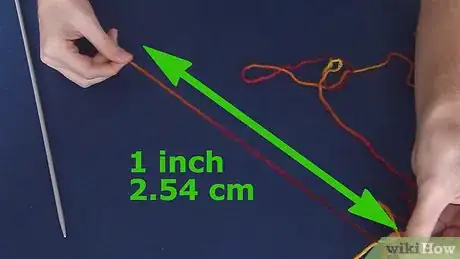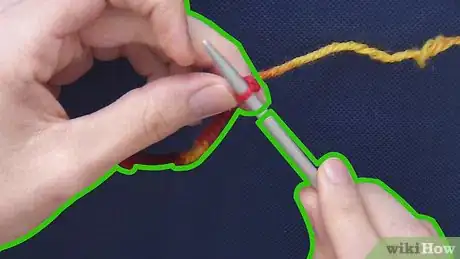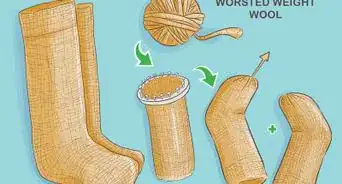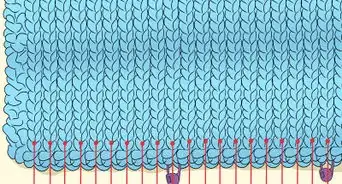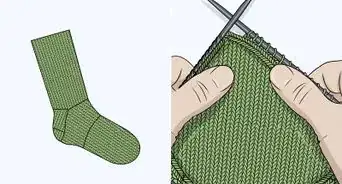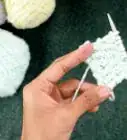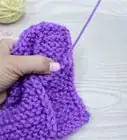This article was co-authored by Nancy Wynn. Nancy Wynn is a lifelong knitter based in Minnesota. She is a member of the Minnesota Knitters Guild and the Knitting Guild Association. Her Youtube channel, Wynn Knit, has over 10,000 subscribers.
This article has been viewed 1,514,039 times.
Casting on is the often the first step of any knitting pattern. It is simply putting the yarn and the stitches onto the needle. There are different ways to cast on, and each has its own purpose. Start with a basic, backward loop cast on, then advance to the long-tail cast on and the provisional cast on.
Steps
Getting Started
-
1Use the backward loop cast on if you are new to knitting. This is one of the easiest ways of casting on. Keep in mind, however, that it tends to leave uneven/jagged edges.[1]
-
2Use the long-tail cast on if you want an even and somewhat elastic edge. As the name implies, you will be using both the tail and working yarn to create your stitches. Because of its versatility, it is probably the most popular cast-on among knitters.[2]
- This is a good cast on for stockinette and stitches and ribbed patterns.
Advertisement -
3Know when to use the provisional cast on. This method requires you to crochet a chain first, then knit into the chain. Once you have finished your piece, you can undo the crochet chain, slip the needle back through the loops, and continue knitting downward.[3] Here are some reasons for using the provisional cast on:
- You don't know how to finish the edge of your piece, and want to decide later.
- You don't know how long to make the piece yet, and want to add length to it later.
- You are making several pieces and want to attach them seamlessly.
- You are working with lace and want to create a mirror image.
Casting On with a Backward Loop
-
1Make a slipknot and slide it onto your knitting needle. This will count as your first stitch. To make a slipknot, fold some yarn in half to make a loop in your non-dominant hand. Then, bring the tail end over the working end of the yarn so it crosses. Use the thumb and finger of your non-dominant hand to make a single loop, and poke your knitting needle through this loop. Gently tug on the yarn and yarn tail to tighten the knot.
-
2Hold the needle in your hand and wrap the yarn around your thumb from behind the working yarn. Push upward until you form a loop.
-
3Bring the needle in front of your thumb and the strand of yarn. The tip of the needle should be pointing towards your thumb.
-
4Slip the needle under the yarn around your thumb. Make an upward motion with the needle as you do this.
-
5Pull your thumb out and tug on both strands of yarn. Make the loop snug, but do not make it too tight.
-
6Push the loop down towards the slipknot, and adjust if necessary. Both the cast on loop and the slipknot should be the same size and tension. You may need to tighten or loosen the knots to do this.
-
7Keep repeating the steps until you have the number of stitches the pattern requires. Each cast on equals one stitch. The slipknot also counts as one stitch.
- Try not to make knots too tight, or you won't be able to knit into them later.
Casting On with a Long-Tail
-
1Determine how much tail yarn you will need. You will need approximately 1 inch (2.54 centimeters) of yarn for every stitch needed in the pattern, though this will vary depending on the type of yarn you are using. This is how long the tail should be once you put the yarn onto the needle.
-
2Attach the yarn to the needle. Hold the needle in your dominant hand. With both strands in the palm of your non-dominant hand, take your thumb and index finger in between the two strands and spread them apart. Make a loop in the length of yarn that is stretched between your thumb and finger and slide your knitting needle through the loop. tugging gently to tighten.
-
3Tug the needle gently downward to form a loop around your thumb. The tail yarn is over the back of your thumb; the working yarn is over your index finger. When you pull the needle down, the working yarn crosses over the tail, which forms a loop of yarn around your thumb.
-
4Poke the tip of the needle through the loop around your thumb. The needle should be right next to your thumb. There should be a strand of yarn to either side of the needle. Once you've caught the loop on your thumb, reach the needle over to the index finger.
-
5Grab the strand that's coming off of your finger. Take that strand that's now on your needle, bring it down through the loop that is on your thumb.
-
6Use the needle to pull tail back through the thumb loop. Try to use an upward motion, pushing down on the end of the needle so that the tip points towards the ceiling.
-
7Pull your thumb out and gently tighten the loop around the needle. The stitch is created with the yarn wrapped around your index finger. Gently tug on yarn strands to tighten the stitch.
-
8Push the stitch down towards the slipknot. Make sure that both stitches are the same size and tension. You may need to tighten or loosen the yarn in order to do this.
-
9Keep repeating the steps until you have the number of stitches you need. Each loop that goes onto the needle counts as one stitch. This includes the slipknot.
Doing the Provisional Cast On
-
1Make a chain stitch using a crochet needle two times the size of your knitting needle. It is best to use a smooth, light colored yarn. Keep making chains until you have the same number of stitches your pattern requires, then add at least six more chains.[4] Here is how to make a crochet chain stitch:[5]
- Make a small circle with the yarn. The tail end should be on top of the ball end. Both ends should be facing in opposite directions.
- Poke the a crochet needle through the circle and catch it onto the tail end.
- Pull it through the circle partway so that you have a loop.
- Take the hook out and poke it through the loop you just made. Gently tug on the tail end and ball end of the yarn, tightening the loop. The yarn should now be on your crochet needle.
- Fold the ball end of the yarn over the hook and away from you.
- Use the hook to pull the yarn through the slipknot. This will cause the slipknot to fall off the hook. This is one chain stitch. To make another, fold the yarn over the hook, towards yourself. Use the hook to pull it through the loop so that it is on the crochet needle.
-
2Pull the chain off the crochet needle. Be gentle with it so that it does not unravel. Once it's the length you need, cut it free of the working yarn. Take the end and pull it back through the last chain you worked to secure the chain and to keep it from unraveling. Take what's left of the tail and make a temporary slip knot — this is the end you will unravel to release your stitches.
-
3Hold the chain in your left hand and the needle in your right hand. You will notice that one side of the chain looks like a row of V's. The other side looks like a chain with bumps. You will be sticking the needle into these bumps.
-
4Stick the tip of the needle into the third bump of the crochet chain. You don't want the needle to be sticking all the way through the bump — stick it just far enough so that you can catch yarn with it.
-
5Drape the ball end of the yarn over the tip of the needle. Be sure to leave a tail that is several inches long. Hold the yarn tight over the needle.
-
6Use the needle to pull the yarn through the bump.[6] Try pointing the tip of the needle upward as you pull it through the bump. The loop that ends up on your needle is your first stitch.
-
7Repeat the steps until you have cast on the number of stitches that the pattern requires. Keep slipping the needle through the bumps in the chain, and pulling loops of yarn through.
Community Q&A
-
QuestionAfter casting on, do I need to bind off at the end of the pattern?
 LibraryMouseCommunity AnswerYes.
LibraryMouseCommunity AnswerYes. -
QuestionHow should I incorporate a new color of yarn?
 LibraryMouseCommunity AnswerTie the second piece of yarn to the first and just keep going.
LibraryMouseCommunity AnswerTie the second piece of yarn to the first and just keep going. -
QuestionHow would I cast on two strands of yarn?
 LibraryMouseCommunity AnswerHold them together as you cast.
LibraryMouseCommunity AnswerHold them together as you cast.
Things You'll Need
Casting On with a Backward Loop
- Pair of knitting needles
- Yarn
Casting On with a Long-Tail
- Pair of knitting needles
- Yarn
Doing the Provisional Cast On
- Crochet hook
- Contrast yarn
- Pair of knitting needles
- Yarn
References
- ↑ Knitting Help, Backward Loop Cast-On
- ↑ Knitting Help, Long Tail Cast-On
- ↑ The Purl Bee, Provisional Cast On: a Two-Step Method
- ↑ Tricksy Knitter, How to Cast On: Making a Provisional Cast On
- ↑ Annie's Catalog, Lesson 2: How to Slip Knot & Chain Stitch
- ↑ Tricksy Knitter, How to Cast On: Making a Provisional Cast On
- Videos provided by Nancy Wynn
About This Article
To cast on while knitting, first make a loop with the tail end of the yarn near the end of the yarn. Then, take the working end of the yarn and make a second, smaller loop with it. Pass the smaller loop up through the bigger loop, and pull on it to tighten the knot. Pass your knitting needle through the loop, then tighten the knot around it. This slip knot is your first stitch. From there, wrap the working end of the yarn around your thumb. Pass the needle up through the loop around your thumb, and pull the loop off your thumb with the needle. Now, pull on the working end of the yarn to tighten the loop around the needle. Push the loop down toward the first knot you made to finish the stitch. To make another stitch, loop the working end of the yarn around your thumb, and pull the loop off with the needle like you did before. Then, tighten the loop around the needle next to the previous stitch. Repeat the process until you’ve made the number of stitches that your pattern requires. For more tips, including how to cast on with a long tail, scroll down!

